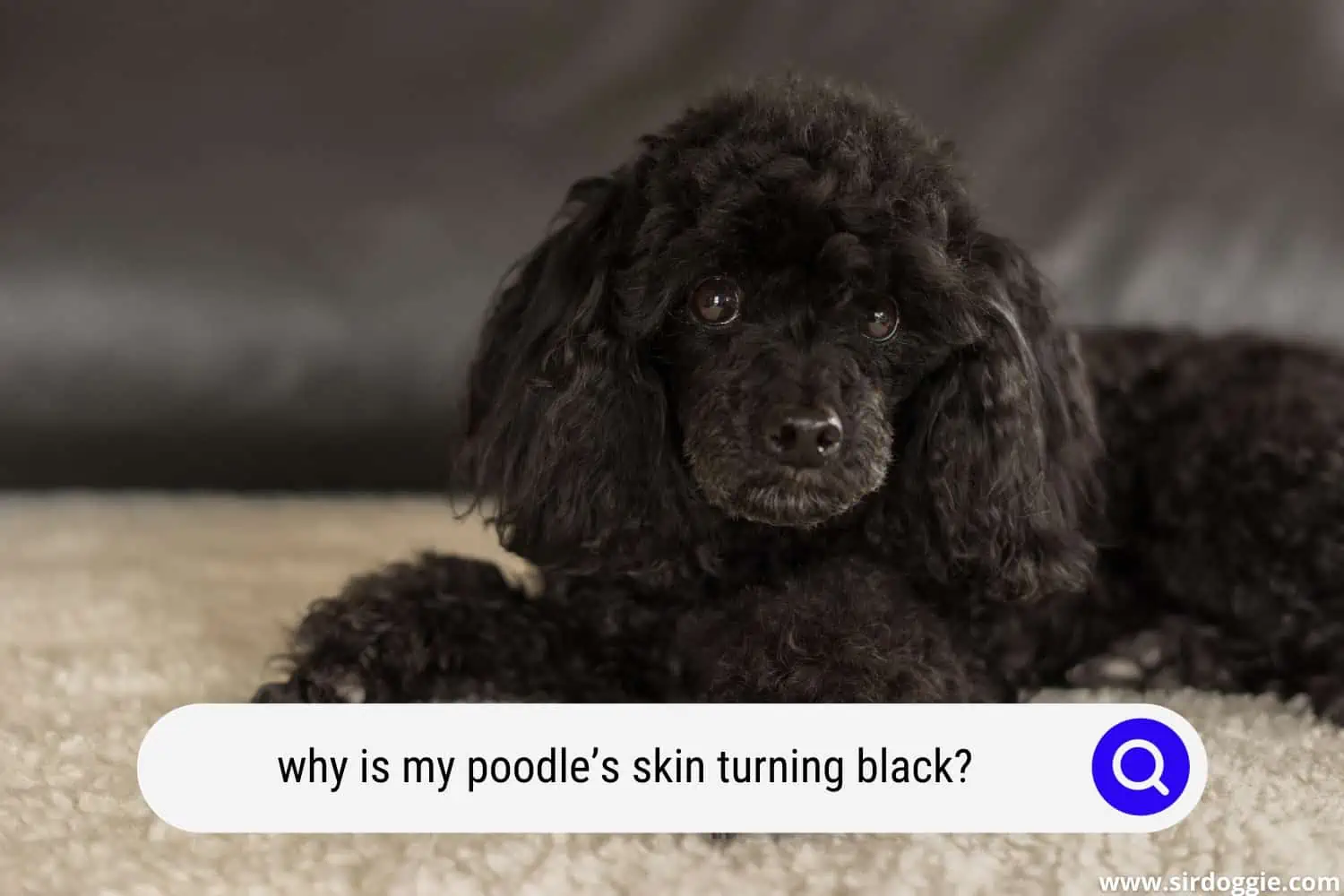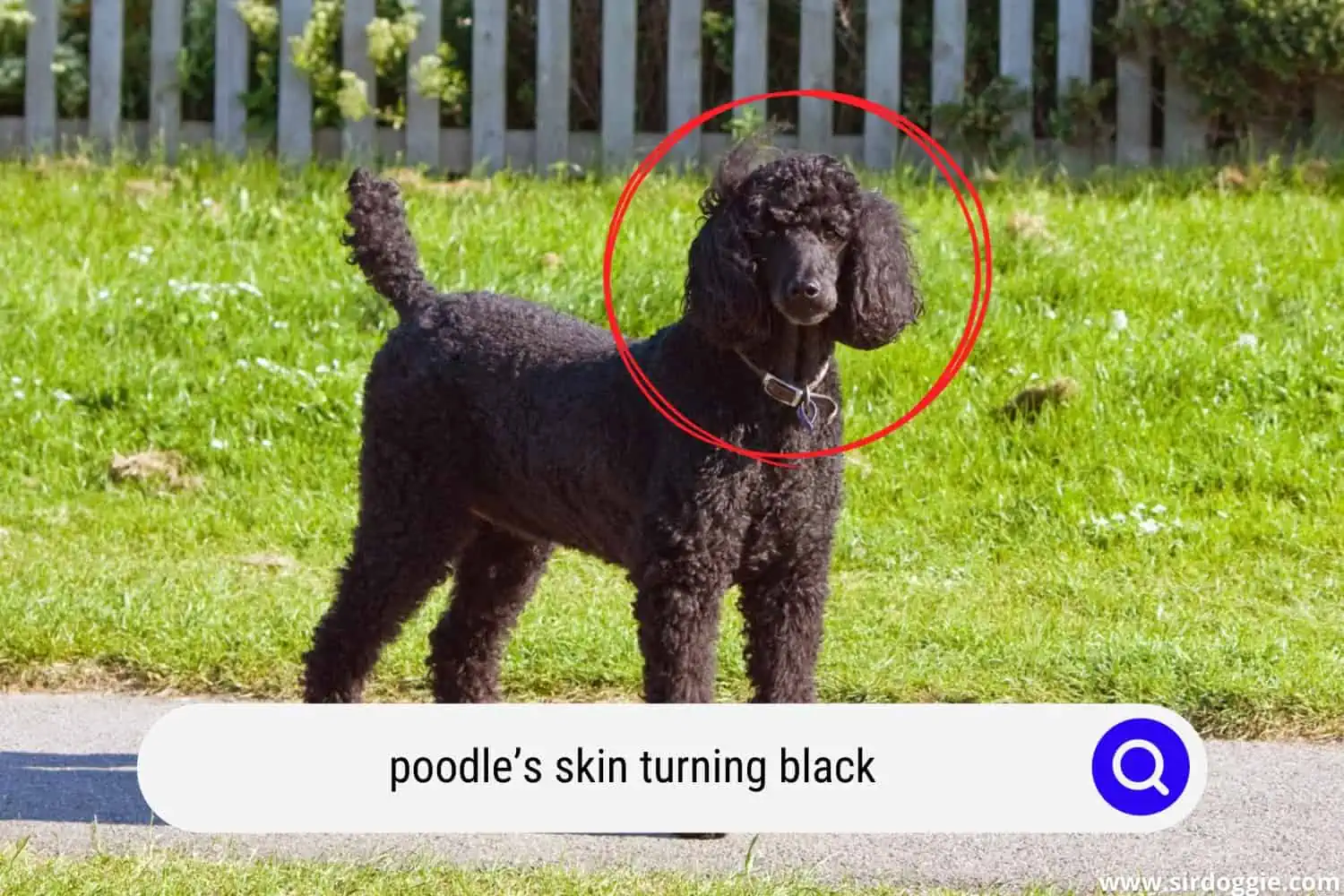Why is My Poodle’s Skin Turning Black?
Among all the many types of dogs, the poodle is a breed most likely to show off its skin — as their owners typically like to keep them well-groomed. However, all this trimming and clipping could expose something that could nudge any curious owner to ask: Why is my poodle’s skin turning black?

Most of the time it’s natural for the skin of dogs, especially poodles, to darken with exposure to the sun, or just with aging due to genes and heredity. That bright pink new skin you see on puppies does not always remain through a dog’s life — and it does not have to be alarming.
There are some exceptions, which we will explore below. But for the most part, if a poodle’s skin turns black, or even starts to darken or show dark spots over the years, it doesn’t mean it’s harmful for your pet.
Unharmful Darkening of a Poodle’s Skin
Most poodle owners remember their little pooch when very small, or that first time when it was groomed with hairs trimmed down very short in places. There was that baby pink hue, which made the dog even more adorable once groomed.
Then, over a year or several years, that pink skin darkens. Here are some causes, none of which mean your dog is in harm’s or otherwise ill:
- Sun. Yes, poodle skin can get tanned, if exposed to sunshine extensively.
- Age spots. Again, just like with our own human skin, a dog’s skin can show signs of aging. Over time the skin underneath their hair can show dark spots, of any size or shape.
- Hyperpigmentation. There’s a whole list of causes for this condition, which basically means changed skin pigment (e.g. darkening), and some of the most concerning are listed below. Not-so-concerning causes of hyperpigmentation could be the below-mentioned over-licking or -scratching, or a yeast infection which can be treated.
It’s important to note that darkened skin on a dog is obviously more noticeable, even dramatic, for dogs with light fur — like the fairly common white poodles.
Some owners with poodle knowledge say a white poodle’s skin normally turns dark grey, or even black — especially if they are in the sun a lot. However, if you notice in those areas of darkness that the skin is also thickening, or there is hair loss, or otherwise irritating the poodle, then it might be time to monitor closely.
Poodle Skin Changes: When to Call the Vet
When a poodle’s skin turns black or starts to darken, you don’t have to change any routines in terms of petting or grooming. Just pay attention to the dog’s reaction to the change, as well as other new developments like smells.
- Sometimes dog skin darkens due to excessive scratching or licking by the dog. This could be caused by an allergy, or some sort of exterior source like bug bites, and may require a call to your veterinarian.
- If the darkening skin causes a bad odor, it could indicate a condition or infection that needs vet attention. Much of the time this is a yeast infection, and it is treatable.
The biggest clues to whether changing dog skin is a problem rests with the dog. If something bothers your pet in some way, he or she should act differently about it. Maybe they keep sniffing or licking the area, or favor one side over the other, for a reason.
If you pay attention to your dog’s habits and tendencies, these changed actions should stand out. Whenever you suspect an infection or illness in your pet, it is wise to contact your vet — and not rely on suggestions from friends or online sources only.
Dog Skin Changes Rarely Develop Overnight
Dog skin color changes typically occur over a significant amount of time. If you’re just noticing it, think back many months to any particular changes for the pet, like its diet, or where you let it run free. Did you feed it raw meats? Was it running among fields with a lot of flowers or loose small leaves? This could mean allergies, which you can discuss with the vet to treat.
Changed skin color in dogs is typically related to some kind of continued exposure or trauma, which causes hyperpigmentation. These traumas, such as allergies that cause excessive itching and scratching, can be treated. Remember back many weeks or months, and think whether you notice redness in any areas of the dog’s body, or spots where he or she licked frequently.
These things over time can cause chronic trauma, which makes the skin eventually change in color. While the skin may or may not resort back to its original color, it’s still important to seek the treatment, for your pet’s comfort and health long-term.
Other Causes of Hyperpigmentation in Dogs
- Aside from yeast infections, bacterial infections are a common cause of infections in the skin of dogs, which could lead to pigmentation changes.
- Mange also can cause a poodle’s skin to darken. This skin disease is caused by mites, and there are 2 types affecting dogs, sarcoptic and demodectic. Sarcoptic mange (sometimes referred to as canine scabies) is the most common and contagious. It causes intense itching, and therefore scratching resulting in sores and hair loss.
- Ringworm also can cause hyperpigmentation for your poodle, temporary or even permanent.

Final Thoughts on Poodle Skin Darkening
Young poodle puppies can naturally have their skin change from pink to a darker hue — kind of like human kids’ hair darkening over time. There are other benign (non-harmful) reasons for poodle skin turning black or darkening, and often it is not a cause for alarm.
However, dog skin can darken due to its body’s response to chronic inflammation, caused by a fungal or bacterial infection, often related to the presence of a parasite. Additionally, hormone imbalances or other causes may need a blood test to detect. If the darkening continues over a lengthy period, it’s best to have your pooch looked at by a veterinarian.
Still, the most common cause of skin color changes in poodles is chronic scratching or licking. From there, it’s just a matter of determining what causes them to do that.
Related Reading: Pug Belly Turning Black – Things You Need To Know

Family Dog Expert Author
Hi there! I’m Stuart, a devoted dog lover and family dog expert with over a decade of experience working with our furry companions. My passion for dogs drives me to share my knowledge and expertise, helping families build strong, loving bonds with their four-legged friends. When I’m not writing for SirDoggie, you’ll find me hiking, playing with my beautiful dog, or studying music.